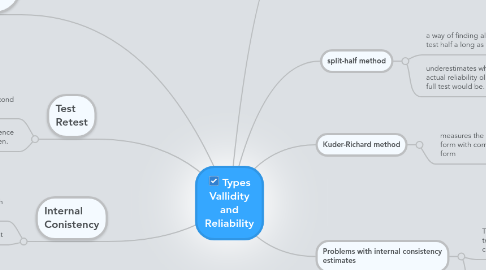Types Vallidity and Reliability
por LaTrece Thomas


1. Content validity evidence
1.1. established by inspecting test questions,
1.2. easy to specify what should be included in the content of a text.
1.3. easier to identify when on acheivement test
1.4. does not yeild a numerical index, but instead yeilds a logical judgement as to whether the test measures what it is supposed to measure.
2. Test Retest
2.1. The test is given twice and the correlation between the first set of scores and the second set of scores is determined
2.2. there is usually some memory or experience involved the second time the test is taken.
3. Internal Conistency
3.1. items should be correlaated with each other
3.2. test ought to be internally consistent
4. Criterion Related Validity Evidence
4.1. Concurrent criterion-related validity evidence
4.1.1. determined by adminstering both new and established test to a group of respondents then finding the correlation between the two sets of test scores
4.2. Predictive validity evidence
4.2.1. useful and important for aptitude test
4.2.1.1. New node
4.2.2. should predict who will do well with what kind of thereapy.
4.3. Refers to how well the test predicts some future behavior of the examinees
4.4. concurrent criterion-related and predictive validity evidence yeild numerical indices of validity.
5. split-half method
5.1. a way of finding alternate-form reliaility for a test half a long as the original test.
5.1.1. New node
